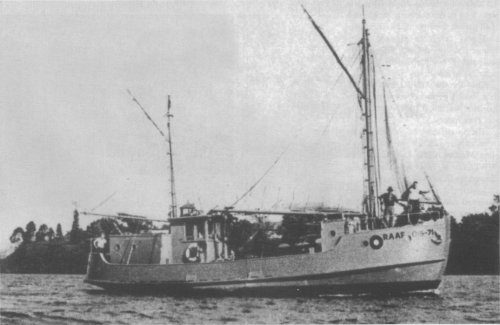- Author
- Dare, Tim
- Subjects
- History - general, Ship histories and stories, History - WW2
- Tags
-
- RAN Ships
- None noted.
- Publication
- December 1999 edition of the Naval Historical Review (all rights reserved)
The New Zealand scow was developed from the Canadian/US log barges that plied the Great Lakes during the 1800s.
First built in New Zealand in 1873 for Septimus Meiklejohn of Omaha, North Island, they gradually changed from a crude sailing barge to quite fine sailing workhorses in their own right.
Typically they were flat-bottomed, centreboard, kauri wood construction of very shallow draught, ranging in size from 40 ft to 128 ft.
They were used for carrying an infinite variety of cargo, and instrumental in the early development of New Zealand.
Auxiliary Scow “ECHO”
The scow Echo, now beached on Picton’s eastern harbour, has had an interesting and varied past. She is currently being renovated for use as a cafe and bar in conformity with the historical significance of the old trading scows.
She was built in 1905 at Te Kopuru, on the northern Wairoa River, by William Brown & Sons. She was a topsail schooner, with a Hercules oil engine of 20 hp as an auxiliary. Her hull was a square bilge scow type, of shallow draught, which had been evolved in the days when most of the country’s cargo went by sea between river mouth or upper river harbours. Large centreboards were lowered to prevent leeward drift when sailing.
About 1916 she was bought by Richardson’s – a well-known Napier shipping firm – for transporting meat from Wairoa Freezing Works to Napier. The following year she was fitted with two Skandia semi-diesel engines of 40 hp each. This service ceased when the railway was completed between Wairoa and Waikokopu, where overseas ships loaded in the roadstead. It was then, in 1920, that the Echo was purchased by Eckfords for their river services out of Blenheim – commencing service between Blenheim and Wellington in 1921.
Even after she was fitted with bigger engines as her main means of propulsion, and had her top masts removed the Echo still carried sails which were used to steady her against rolling in beam seas in Cook Strait. She was by far the last ship plying commercially under sail in New Zealand waters.

Photo courtesy of Dunlop Slazenger Australia and Ryde City Council Local Studies Librarian
Her worst misadventure happened on 26th November 1932. Approaching Wellington in a southerly gale, she was caught in a blinding squall, driven on to the rocks at Pencarrow Head and holed. The crew abandoned ship and made the shore safely, but the ship drifted off, filled with water and rolled over. In this state she floated up the harbour and was retrieved the next day by the tug Toia with the floating crane Hikitea righting her. The cargo was a total loss but the hull was repaired without difficulty.
One of the highlights of Echo’s career was her service in the last war. She was requisitioned in 1942 by the US Navy as supply ship for the New Hebrides/Solomons/New Guinea area, where she rendered sterling service in these dangerous waters under her American crew.
Perhaps her unwarlike appearance was some protection. As far as is known in New Zealand she aided the destruction of two Japanese submarines and suffered only one unsuccessful attack by a Japanese aircraft during the period. When the need for her services ended in 1944 she was reconditioned and bought back by Eckfords to resume her old run (Blenheim to Wellington).
Much new material went into her hull after her Pacific service when teredo worm got into her, but the original kauri frame timbers still in her have been turned into a purplish black, tough and everlasting, form which withstood the destructive insect.
Sound as she still was in 1965, it was sheer economics which marked her for retirement. The modern road and rail ferries forced many coastal services out, and the Echo was particularly vulnerable being on the Cook Strait service. Attempting to compete with the GMV Aramoana was futile. Regretfully Echo was withdrawn.
Her war service was the theme of a Hollywood film released in 1961 called “The Wackiest Ship in the Army”. The film company wanted to charter or buy her and offered Captain Eckford £20,000. As there was no other suitable vessel to take her over, the offer was declined.
Now, thanks to Tim Dare, the Echo is undergoing refurbishment. She is undoubtedly a great asset to Marlborough, and will truly be a cafe with “atmosphere”.
A.S. Echo
Stranded 15+ times
Damaged 16+ times (engines, shafts & props)
Fires 3 (Napier 10/01/1911, galley 21/01/1920, Tool Cupboard 1995)
Collisions 7 (1 outhouse on Opawa River, 1 Beacon Wellington, 5 ships)
Loss of life 1 (unknown seaman 19/06/1905, Karamea Bar)




